Fable Legends Early Preview: DirectX 12 Benchmark Analysis
by Ryan Smith, Ian Cutress & Daniel Williams on September 24, 2015 9:00 AM ESTDiscussing Percentiles and Minimum Frame Rates
Up until this point we have only discussed average frame rates, which is an easy number to generate from a benchmark run. Discussing minimum frame rates is a little tricky, because it could be argued that the time taken to render the worst frame should be the minimum. All it then takes is a bad GPU request (misaligned texture cache) which happens infrequently to provide skewed data. To this end, thanks to the logging functionality of the benchmark, we are able to report the frame rate profiles of each run and percentile numbers.
For the GTX 980 and AMD Fury X, we pulled out the 90th, 95th and 99th percentile data from the outputs, as well as plotting full graphs. For each of these data points, the 90th percentile should represent the frame rate (we’ll stick to reporting frame rates to simplify the matter) a game will achieve during 90% of the frames. Similar logic applies to the 95th and 99th percentile data, where these are closer to the absolute maximum but should be more consistent between runs.
This page (and the next) is going to be data heavy, but our analysis will discuss the effect of CPU scaling on percentile data on both GPUs in all three resolutions using all three CPUs. Starting with the GTX 980 Ti:
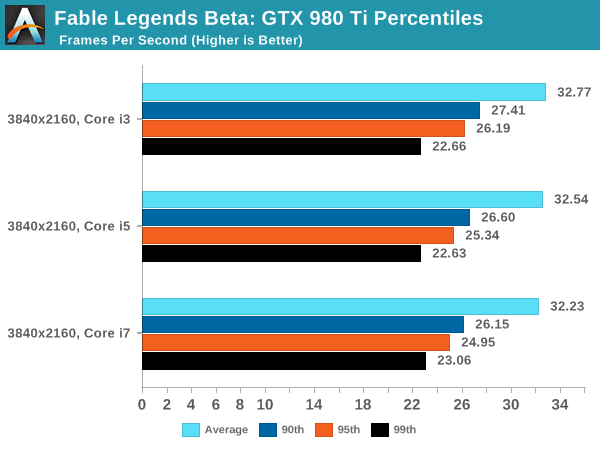
All three arrangements at 3840x2160 perform similarly, though there are slight regressions moving from the i3 to the i7 along most of the range, perhaps suggesting that having an excess of thread data has some issues. The Core i7 arrangement seems to have the upper hand at the low percentile (2%-4%) numbers as well.
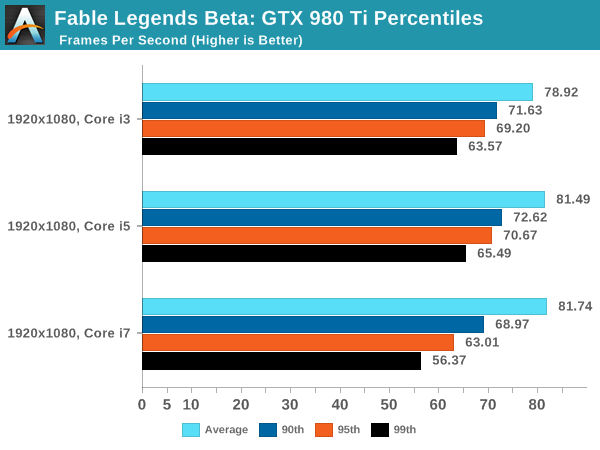
At 1080p, the Core i7 gives greater results when the frame rate is above the average and we see some scaling effects when the scenes are simple (giving high frame rates). But for whatever reason, when the going gets tough the i7 seems to bottom out as we go beyond the 80th percentile.
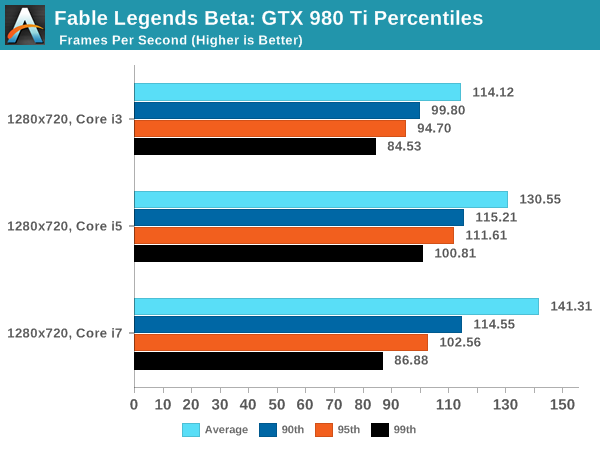
If we ever wanted to see a good representation of CPU scaling, the 720p graph is practically there – all except for the 85th percentile and up which makes the data points pulled out in this region perhaps unrepresentative of the whole. This issue might be the same issue when it comes to the 1080p results as well.


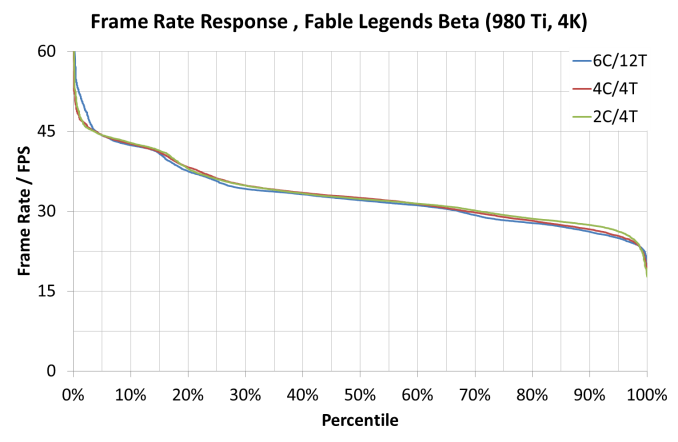
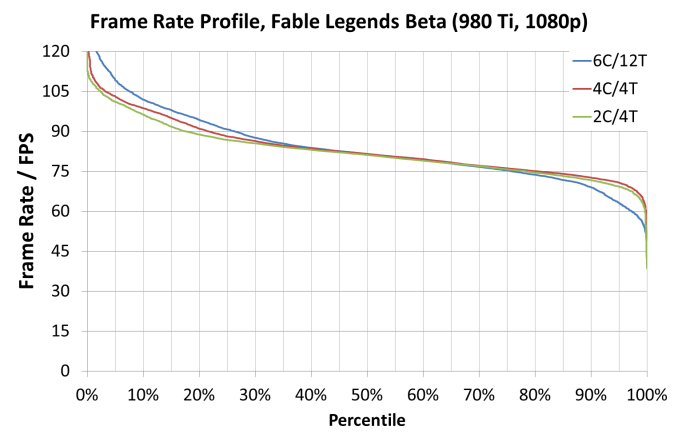
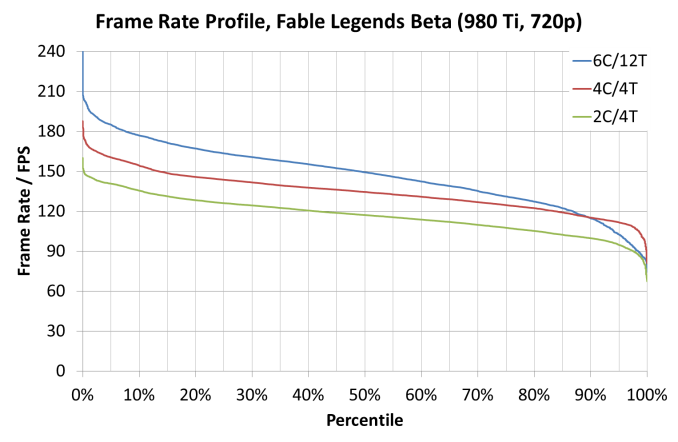








141 Comments
View All Comments
piiman - Saturday, September 26, 2015 - link
"Yes, but when the goal is to show improvements in rendering performance"I'm completely confused with this "comparison"
How does this story even remotely show how will Dx12 works compared to Dx11? All they did was a Dx12 VIDEO card comparison? It tells us NOTHING in regard to how much faster Dx12 is compared to 11.
inighthawki - Saturday, September 26, 2015 - link
I guess what I mean is the purpose of a graphics benchmark is not to show real world game performance, it is to show the performance of the graphics API. This this case, the goal is trying to show that D3D12 works well. Throwing someone into a 64 player match of battlefield 4 to test a graphics benchmark defeats the purpose because you are introducing a bunch of overhead completely unrelated to graphics.figus77 - Monday, September 28, 2015 - link
You are wrong, many dx12 implementation will help on very chaotic situation with many pg and big use of IA, this benchmark is usefull like a 3dmark... just look at the images and say is a nice graphics (still Witcher3 in DX11 is far better for me)inighthawki - Tuesday, September 29, 2015 - link
I think you missed the point - I did not say it would not help, I just said that throwing on tons of extra overhead does not isolate the overhead improvements on the graphics runtime. You would get fairly unreliable results due to the massive variation caused by actual gameplay. When you do a benchmark of a specific thing - e.g. a graphics benchmark, which is what this is, then you want to perform as little non-graphics work as possible.mattevansc3 - Thursday, September 24, 2015 - link
Yes, the game built on AMD technology (Mantle) before being ported to DX12, sponsored by AMD, made in partnership with AMD and received development support from AMD is a more representative benchmark than a 3rd party game built on a hardware agnostic engine.YukaKun - Thursday, September 24, 2015 - link
Yeah, cause Unreal it's very neutral.Remember the "TWIMTBP" from 1999 to 2010 in every UE game? Don't think UE4 is a clean slate coding wise for AMD and nVidia. They will still favor nVidia re-using old code paths for them, so I'm pretty sure even if the guys developing Fable are neutral (or try to), UE underneath is not.
Cheers!
BillyONeal - Thursday, September 24, 2015 - link
That's because AMD's developer outreach was terrible at the time, not because Unreal did anything specific.Kutark - Monday, September 28, 2015 - link
Yes, but you have to remember, Nvidia is Satan, AMD is Jesus. Keep that in mind when you read comments like that and all will make senseStuka87 - Thursday, September 24, 2015 - link
nVidia is a primary sponsor of the Unreal Engine.RussianSensation - Thursday, September 24, 2015 - link
UE4 is not a brand agnostic engine. In fact, every benchmark you see on UE4 has GTX970 beating 290X.I have summarized the recent UE4 games where 970 beats 290X easily:
http://forums.anandtech.com/showpost.php?p=3772288...
In Fable Legends, a UE4 DX12 benchmark, a 925mhz HD7970 crushes the GTX960 by 32%, while an R9 290X beats GTX970 by 13%. Those are not normal results for UE4 games that have favoured NV's Maxwell architecture.
Furthermore, we are seeing AMD cards perform exceptionally well at lower resolutions, most likely because DX12 helped resolve their DX11 API draw-call bottleneck. This is a huge boon for GCN moving forward if more DX12 games come out.
Looking at other websites, a $280 R9 390 is on the heels of a $450 GTX980.
http://techreport.com/review/29090/fable-legends-d...
So really besides 980Ti (TechReport uses a heavily factory pre-overclocked Asus Strix 980TI that boosts to 1380mhz out of the box), the entire stack of NV's cards from $160-500 loses badly to GCN in terms of expected price/performance.
We should wait for the full game's release and give NV/AMD time to upgrade their drivers but thus far the performance in Ashes and Fable Legends is looking extremely strong for AMD's cards.